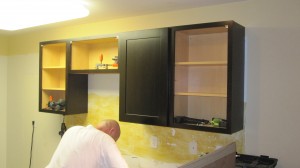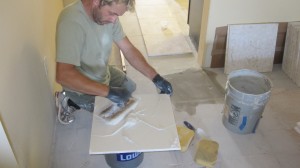Kitchen Remodel Checklist, Part II
1 Comment | Posted by armchairbuilder in Kitchen Remodel, Owner-Builder, Quality Check
In the last post (Kitchen Remodel Checklist, Part I) we talked about all the necessary steps to tackle before you start demolition/construction of your new kitchen remodel. Here we will discuss demolition, construction, scheduling, and how to minimize the affects of construction on the rest of your home.
- Demolition: Once we have our materials, we can start demolition. Assuming you will be living in the home during construction, we want to shorten the schedule as much as possible. For this reason,we wait to start demolition until all materials have arrived or are in stock and on hold. Don’t rely on “supposed to be” or “maybe” from your suppliers…these will get you into trouble. There is nothing worse than having your kitchen torn apart with nothing going on. As for the items removed during demolition, I try to save anything that could still be used and donate it to Habitat Restore. If you don’t have a Restore by you, try calling the local Habitat for Humanity to see if they can use your items…anytime we can donate or reuse items versus sending them to a landfill is a good thing. I have also used craigslist to sell or give away items. On this kitchen remodel, I gave away a range just because I didn’t want to take it to the landfill. Also, to keep the dust contained to the kitchen, be sure to enclose the area with plastic and be sure you have a bathroom close by for the subcontractors. You might want to consider a portable toilet if you don’t have a bath off the kitchen. These will typically cost you $70 to $80 per month which includes a cleaning once a week.
- Schedule: Here is the typical schedule I use:
– Adjust Framing: Includes moving/adding walls, adding soffits, kneewalls…etc. Depending on the extent of your changes, this should only take a day.
– Mechanicals (Plumbing, HVAC, Electrical): I typically go in this order as plumbing drains are pretty much fixed in location, HVAC is next and then electrical. You will want to go over the plan with each trade before starting to make sure they avoid the spaces you need for the other mechanicals if possible. For the typical kitchen remodel, I would figure a day for each mechanical trade.
– Rough Inspections: Check with you building department for their inspection process. Also ask about particular requirements they may have for kitchens: they may have specific range ducting requirements, smoke/carbon monoxide detector locations, GFCI locations,…etc.
– Insulation: Don’t forget to properly insulate and draft stop any soffits you add…these can be a problem in cold climates. This should only take a partial day (again, if you have a really big project, it could take two days)
– Drywall Hang and finish: The time required to finish drywall can really be affected by temperature and humidity. But assuming normal conditions, I would figure four to five days.
– Prime and apply first coat of paint: Make sure the guys remove drywall dust from the walls before priming. You should be able to get this done in 1 or 2 days.
– Install Cabinets/Cabinet Trim: Cabinet installation is usually a one day job for a professional. If your kitchen is large, they may need to return a second day to finish up hanging cabinets and installing cabinet crown, light rails…etc. Don’t forget to have your installer shim the base cabinets up to match the thickness of your flooring choice.
– Install Trim and Doors: This typically takes one to two days depending on what type of trim and doors you use. I like to have my painter pre-stain or pre-paint the trim and doors before they are installed. This can be done anytime before the trim carpenter shows up. Just be sure to allow for proper drying. Also keep in mind, you will still need to touch up at the end of the schedule but this gives you a huge head start.
– Deliver Appliances: This assumes you have room to store them out of the kitchen. If you have a smaller condo, you may want to have the refrigerator and slide in range brought in later.
– Template for Granite or Solid surface countertops: This should be done immediately after the base cabinets are installed. Granite and solid surface countertops can take up to two weeks to fabricate and install so, we want to get them measured as soon as possible. Make sure you have your sinks, faucets and appliances on site at the time of measure. Many fabricators will take your sink back with them and secure it to the top at their shop. They will also need the faucets to know how big to drill the holes (you will go over locations). If you have a freestanding range, slide in range or cooktop, it’s a good idea to have it on site at this time as well. This way, the fabricator can make sure the cutouts and edges fit perfectly. Check your dishwasher to see if you will need holes drilled in the underside of the countertop. Many dishwashers require you to secure two screws up into the underside of the counter to secure it in place. This can be difficult when you have granite or some other hard material so see if your fabricator can help.
– Hard Flooring: For tile, I like to grout at the end of the job and for site finished hardwood I put the last coat of sealer on at the end of the job…this helps protect the finished product.
– Install Countertops
– Final Mechanicals (plumb kitchen sink, install switches, light fixtures, hookup appliances…etc.). Make sure you run all of your appliances and check for leaks. Be sure to look under your dishwasher after running it and look behind your refrigerator if you have an icemaker water line.
– Final Paint: Includes walls, doors and trim.
This schedule can be adjusted to fit your particular circumstance. Some people like to install the flooring prior to cabinets but as long as your floor installer is careful with the cabinets, your schedule will go faster by installing cabinets first. That way, you can template for countertops and get them fabricated while the flooring is going in. This could end up saving you four or five days in the schedule. Just be sure you raise up the cabinets to the thickness of the floor you are installing. I typically have my trim carpenter cut small blocks of plywood. This way, your cabinets and toe kicks don’t end up being short. Also, by installing the flooring after cabinets, you will save on your flooring budget as you will have less square footage for material and labor. Some people will laugh at this last comment but I have saved upwards of $500 by not installing flooring under the cabinets. One other thing to think about…you will most likely replace your floor before replacing the cabinets…this has been my experience anyway. If you run the floor under the cabinets, it is harder to remove the old floor.
- Be prepared for the unexpected. Things will go wrong no matter how hard you try to pre-plan your project. My last kitchen remodel had several issues during the build out. First, we chose a 18″ by 18″ square coral stone for the floor (basically a limestone). This new tile was a quarter inch thicker than the previous. With the thicker stone, the front entry door would not clear. So, I had to remove the door, cut it down and add a new threshold piece (the threshold was not adjustable). The next problem involved the pullout pantry cabinet we chose to install in the corner of the kitchen in front of the window. The window sill had to be removed so the cabinet would clear when pulled out. We drywalled the sill and had to search “high and low” for a window covering that would not protrude past the window jamb.
Yes, you will run into problems with any building project. You just need to evaluate each problem and come up with the best possible solution for your circumstances. A nice new kitchen remodel is a great project for the owner-builder. For more information about becoming an owner-builder and scheduling your own new home project go to our video…Build Your Own House: The Schedule.




[…] turned to our next post “Kitchen Remodel Checklist, Part II” as I will share with you my schedule and a few tips for living in the house as you […]